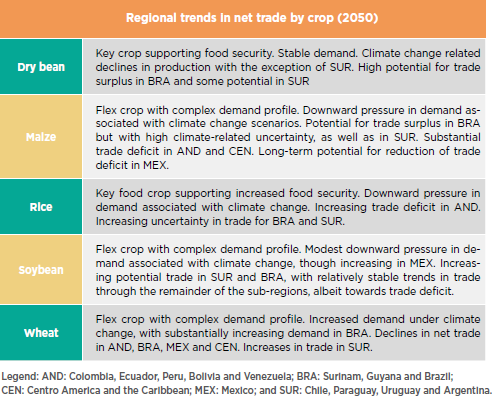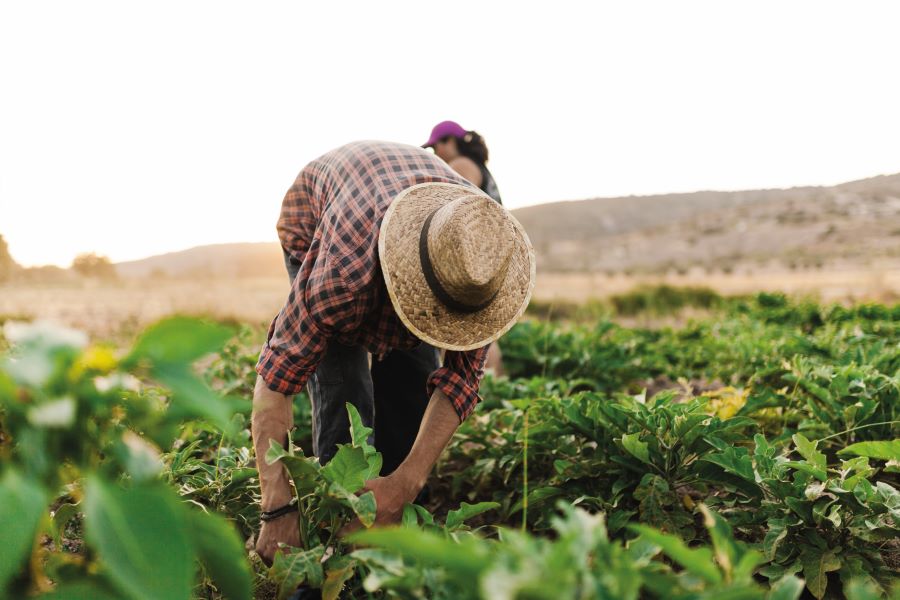Since breakfast this morning, the chances that you consumed either some beans, maize, rice, soybean and wheat are very high indeed. These staples represent key crops in Latin America and the Caribbean and are critical for export earnings and food security. Yet due to the climate crisis, these crops and the region’s agriculture sector faces considerable challenges.
The region accounts for about a quarter of global exports in agricultural and fisheries products. The sector is also very important for export earnings and livelihoods. In 2018, 14.1% of the region’s labor force was employed in agriculture.
Yet, LAC alongside other regions face increasing challenges given the acceleration of global heating, increasing consumption of animal protein, the gradual depletion of natural resources, increased concentration of land ownership, limited access of small farmers to increasingly complex technologies and persistent or growing inequality.
Agricultural economies in LAC will face increasing challenges posed by climate change and variability, including rising temperatures, changing rainfall patterns and more intense and frequent extreme weather events. These changes could affect yields and food security. Jobs could also be affected: Due to heat stress, 2.5 million jobs could be lost in LAC, which would particularly affect the agriculture and construction sectors.
At the global level, the region hosts three out of the ten countries most affected by extreme weather events during the 1998-2017 period, which have negatively affected agriculture and produced considerable losses to livelihoods and economies. In Argentina for example, flooding has already caused losses of an estimated USD 3 billion per year over the past two decades.
Climate models project more exposure to food insecurity in LAC
The study, Climate change vulnerability and economic impacts in the agricultural sector in Latin America and the Caribbean, estimates the potential impact of climate change on agricultural productivity and trade of key crops at regional and country levels in the region. It looks at the situation in Argentina, Bolivia, Colombia, Costa Rica, Ecuador, El Salvador, Guatemala, Honduras, Jamaica, Mexico, Panama, Peru, the Dominican Republic and Uruguay and provides recommendations for adaptation measures for specific crops.
Climate models project an average 1°C-4°C degree increase in temperatures in LAC and a 30% decrease in rainfall. This innovative research finds that globally, in a “no climate change scenario” (No-CC) prices for beans, maize, rice, soybean, and wheat are projected to increase out to 2050 by 4.6%, 27.6%, 16.1%, 6.5%, and 11.7% respectively, over their current levels.
But the introduction of climate change amplifies this rise by 14.6%, 15.4%, 10.1%, 0.5%, and 1.7%, respectively. Price increases and trade deficits across the region, suggest the possibility for increased exposure to food insecurity for most countries, with the Southern Cone an exception.
Given these circumstances, most LAC countries will just meet or fall below the critical food supply/demand ratio. The Andean, Mexico, and Central America and the Caribbean regions could face substantial difficulties, in a scenario that is already challenging given the impacts generated by COVID-19 (see table below).

Five critical adaptation measures for reducing vulnerability of the agricultural sector
Adaptation to climate variability and extreme events serves as the basis for reducing vulnerability to long-term climate change. All LAC countries include some sort of adaptation related measures as part of their agricultural related legal framework and as part of their Nationally Determined Contributions (NDC), although implementation remains a challenge. From our analysis, we identify five crucial adaptive measures:
1) Inclusion of climate change considerations to better inform and prioritize policies, strategies, actions and investments and the national and local levels. This includes the use of climate modeling for policies and public investments as well as the availability and dissemination of information that could assist producers in their decision making about production and commercialization matters.
2) Promotion and support to research, development, adaptation, and adoption of improved or less susceptible varieties. For example, those varieties with tolerance to drought, high temperatures, certain pests, and diseases. This is crucial for key food security (for example, maize and beans) crops as well as those lucrative crops for exports (i.e. coffee and soybeans). The identification, conservation and use of ancient varieties has proven to be important as well.
3) Increasing sustainable water management and use. In LAC, the agricultural sector is the main user of water consuming around 70% of the fresh water available. Nonetheless, water availability is decreasing due to unsustainable exploitation of watersheds and climate change impacts. Sustainable water management and use measures are thus an essential adaptation measure. These activities include sustainable irrigation and water reservoirs, watershed management and considerations of the food-energy-water nexus for decision making.
4) Recovery of degraded lands and sustainable intensification to prevent further deforestation. Land use and land-use change emerge as critical features of virtually all mitigation pathways that seek to limit global heating to 1.5°C. In LAC, agriculture and land use change and forestry accounted for more than 42% of emissions in 2016. Given increasing rates of deforestation in some parts of the region due to the expansion of the agriculture and logging sectors, the contribution to emissions could be even greater in 2021. However, the productive capacity of the agriculture sector depends on the conservation of the ecosystems.
5) Implementation of technologies and practices that simultaneously contribute to increase productivity while reducing vulnerability and/or emissions. There are numerous proven climate smart technologies and practices (CSA) that increase productivity while reducing climate vulnerability and/or emissions. For example, those often-called climate smart agricultural technologies/practices such as agroforestry systems, improved varieties, irrigation, crop rotation, integrated pest management, etc. There is an evolving spectrum of CSA options, thus it is key to understand the effectiveness of the different options, test and select the most effective ones in anticipation of future climate impacts.
The inclusion of specific adaptation goals for agriculture in the revised NDCs would be a vital step
There are differences at the national level which must be considered when designing and implementing policies, strategies and actions. Governments have highlighted in their first NDCs the relevance of the agricultural sector for climate action. In their revised NDCs, LAC countries could reduce climate impacts by adopting climate-smart agricultural practices that increase productivity while reducing emissions and adapting to shifting growing conditions.
As the climate crisis worsens, LAC countries are faced with the challenge to produce enough food to feed a growing population while conserving natural resources and ecosystem and adapting to climate change. While the region may have 40% of the world’s biodiversity, 50% of tropical forests and is the biggest crop exporter, adaptation of the agricultural sector to climate impacts will be key for its survival.
Further reading:
Photo: Adobe Stock
Follow us on Twitter: @BIDCambioClima


Leave a Reply